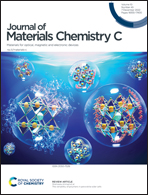Positive and negative electrocaloric effect in the direct and indirect characterization of NaNbO3-based ceramics with tetragonal–cubic phase boundary†
Abstract
The electrocaloric effect (ECE) in lead-free ferroelectric materials has become a significant issue based on the potential of electrocaloric refrigeration to guide a new generation of coolers. However, although the construction of a ferroelectric-paraelectric phase boundary has been widely performed to optimize the ECE due to the large polarization change, its relative effect on indirect and direct characterization is still not clear to date. Herein, a tetragonal–cubic phase boundary was successfully formed in sodium niobate (NN)-based ceramics, together with a reduced Curie temperature (TC) and increased relaxor behavior with an increase in composition (x). The maximum electrocaloric temperature change (ΔTmax) and its subsequent operating temperature decreased with an increase in the content of additives, while the temperature span (Tspan) gradually increased. Notably, a novel phenomenon of negative electrocaloric temperature change (ΔT) was revealed for indirect characterization around the temperature range for the coexistence of tetragonal and cubic phases, whereas positive values were obtained for direct characterization. This difference originated from the different mechanisms between the indirect and direct methods for the ECE. The negative values were induced by the enhanced polarization with an increase in temperature in the indirect method, originating from the coexistence of a long-range order matrix and a certain amount of polar nanoregions (PNRs), which can promote the polarization rotation under an electric field and overcome the deterioration from thermal disturbance. Nevertheless, the positive values are mainly due to the orientation and re-orientation of the domain with the application and withdrawal of an electric field, yielding a decrease and increase in the degree of disordered polarization during the direct method, respectively. This work is beneficial to optimize the ECE and analyze the internal mechanism of electrocaloric refrigeration.



 Please wait while we load your content...
Please wait while we load your content...